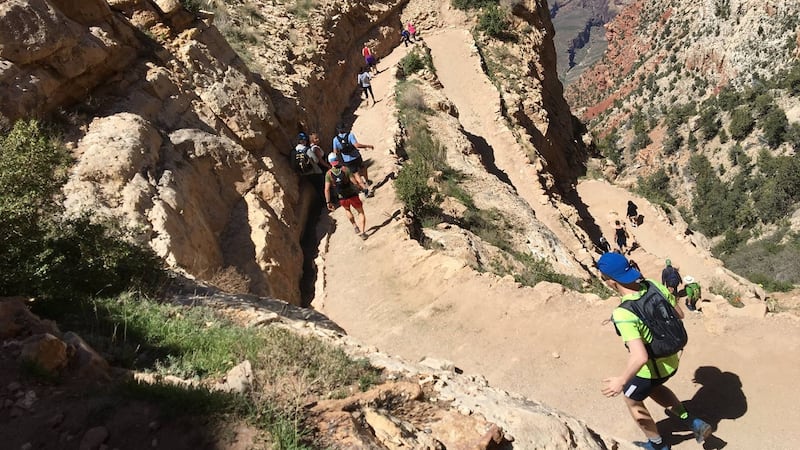I met Brendan O’Neill in the Blue Light pub in Dublin a few weeks ago and he told me about his plan to run across the Grand Canyon. It was early in the night and he wasn’t even drinking and straight away it sounded like an extremely sketchy trip.
Some plans are better shared in advance; others after the result. Running across the Grand Canyon is so perilously tough there was no guarantee he’d survive to even tell the tale.
One mile deep and around 10 miles wide, the run would actually involve seven miles of a lethal switchback descent, more chute than trail, dropping some 5,000 feet, then across the canyon floor and the waist-deep Colorado River, before ascending another seven miles of switchback trail to the top of the far rim. All while enduring seven different climate zones.
The only practical way back is to retrace that trail, making it about 54 miles in all, with almost 20,000 feet of total climbing, a 13-hour round trip. What on earth was his motivation for a run like that?
I’ve known O’Neill for years, a smoothly talented junior from around my old breeding ground of Dundrum, who in 2010 announced himself as one of our most exciting distance running prospects when winning a European Cross Country gold medal with the Irish under-23 team.
They all appeared on the Late Late Show the following Friday, and the least of anyone’s expectations at that stage was that some day he’d run in the Olympics Games.
Entrepreneurial streak
In 2012 he ran 13:41 for 5,000 metres, about 20 seconds off the Olympic qualifying standard, with the assumption was reasonable that he could chip those seconds off in the four years leading up to Rio Games.
He graduated from DCU then transferred to Florida State University, not putting all his eggs in one basket but certainly the best of them.
Because he’s always thought outside the athletics box, three years ago his natural entrepreneurial streak earned him a spot as one of the youngest contestants on RTÉ’s Dragons’ Den, where he managed to win a €30,000 investment for his start-up online sporting apparel company.

Then, around this time last year, that acumen helped him realise this running business just wasn’t going to cut it anymore.
It is what he also told me that night, that he would have been deluding himself had he stayed in competitive running, expecting things to get better, when the necessary support and coaching and training environment simply wasn’t there.
So he retired, aged 28, his best years possibly still ahead of him, but with reality biting much harder than any hope of making Rio.
What followed was the often irrepressible low of a post-Olympic year, which is well flagged for those who get to compete, but not so well documented for those who tried just as hard to qualify and were left with nothing at all.
“Since I was 14 or 15, I’ve always been ‘the runner’, so it was difficult facing into that transition,” he said.
“I never got too low about it, but there was a sort of identity crisis there, family and friends asking me about my next race. Was I going to try for Tokyo?
“ It does get to you, not doing it anymore.”
He thought about training for a big city marathon, London or Boston maybe, but felt stuck in a rut, couldn’t find the motivation. Then in January, three work colleagues told him about their plan to run across the Grand Canyon.
Suddenly it felt like his Eureka moment.
Easier said than done, naturally: their route, known as the Rim-to-Rim-to-Rim (or R3), is a legendary mountainous trail for seasoned ultra-runners, across one of the original Seven Wonders of the World.
O’Neill had done a few runs in the Dublin Mountains over the years, although rather than revive his love of running, the Grand Canyon might well finish him off.
So, last Saturday, having flown to Phoenix, Arizona, and driven to Grand Canyon Village on the south rim, the four of them started out on their run, carrying all their food and medical supplies in a backpack, including head torches.
Cover of darkness
Setting out at noon meant running into the hottest part of the day, but at least it meant returning under the cover of darkness, in the coolness of the night.
The only way into the canyon is by the narrow trial; the only way out in an emergency is by helicopter. There are water taps on the route but no guarantee they’ll work. What’s more, the extreme changes in both temperature and altitude can fool the body and mind into thinking things it shouldn’t. One half-foot in the wrong place would result in serious injury, or death.
It’s one race that is all about the finishing, not the time, and after running several times for Ireland – as recently as the 2014 European Cross Country in Belgrade – Brendan is now openly adamant it was the hardest thing he has ever done.
“At halfway, having run up to the top of the north rim, I thought I was finished, there was no way I’d make it back. Time to call the helicopter.
“Sometimes with competitive runners there’s a bit of snobbery, in terms of fitness, what we think we’re able to do. This shot the lights out on that. ‘Ah, I used to run 100 miles week, 13:40 for 5k, this will be easy . . .’ But not at all. This was the worst I’ve ever felt.
“But then that’s also the thrill, looking back, how you react. And laughing about how tired you were, actually thinking, were you going to die? And at the time you think ‘never again’. Now I’m already thinking ‘where next?’ Not next week, but maybe next year. I thought for a while I might resent running, that it could have gone in another direction, but this has given me the enjoyment back.”















